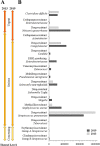Glyconanoparticles as tools to prevent antimicrobial resistance
- PMID: 33728545
- PMCID: PMC7964520
- DOI: 10.1007/s10719-021-09988-6
Glyconanoparticles as tools to prevent antimicrobial resistance
Erratum in
-
Correction to: Glyconanoparticles as tools to prevent antimicrobial resistance.Glycoconj J. 2021 Aug;38(4):491. doi: 10.1007/s10719-021-09995-7. Glycoconj J. 2021. PMID: 33797664 Free PMC article. No abstract available.
Abstract
The increased phenomenon of antimicrobial resistance and the slow pace of development of new antibiotics are at the base of a global health concern regarding microbial infections. Antibiotic resistance kills an estimated 700,000 people each year worldwide, and this number is expected to increase dramatically if efforts are not made to develop new drugs or alternative containment strategies. Increased vaccination coverage, improved sanitation or sustained implementation of infection control measures are among the possible areas of action. Indeed, vaccination is one of the most effective tools of preventing infections. Starting from 1970s polysaccharide-based vaccines against Meningococcus, Pneumococcus and Haemophilus influenzae type b have been licensed, and provided effective protection for population. However, the development of safe and effective vaccines for infectious diseases with broad coverage remains a major challenge in global public health. In this scenario, nanosystems are receiving attention as alternative delivery systems to improve vaccine efficacy and immunogenicity. In this report, we provide an overview of current applications of glyconanomaterials as alternative platforms in the development of new vaccine candidates. In particular, we will focus on nanoparticle platforms, used to induce the activation of the immune system through the multivalent-displacement of saccharide antigens.
Keywords: Antibacterial infections; Glycans; Saccharide antigens; Vaccine platforms.
Conflict of interest statement
The authors declare that they have no conflicts of interest.
Figures


Similar articles
-
Multivalent glycoconjugates as anti-pathogenic agents.Chem Soc Rev. 2013 Jun 7;42(11):4709-27. doi: 10.1039/c2cs35408j. Epub 2012 Dec 19. Chem Soc Rev. 2013. PMID: 23254759 Free PMC article. Review.
-
Prevention of invasive diseases: strategies to increase vaccination coverage in children and adolescents.J Prev Med Hyg. 2012 Jun;53(2):125-9. J Prev Med Hyg. 2012. PMID: 23240175
-
Glycoconjugate vaccines: an update.Expert Opin Biol Ther. 2015 Apr;15(4):529-46. doi: 10.1517/14712598.2015.993375. Epub 2014 Dec 11. Expert Opin Biol Ther. 2015. PMID: 25496172 Review.
-
Advancing Homogeneous Antimicrobial Glycoconjugate Vaccines.Acc Chem Res. 2017 May 16;50(5):1270-1279. doi: 10.1021/acs.accounts.7b00106. Epub 2017 May 2. Acc Chem Res. 2017. PMID: 28463499
-
Glycoconjugate vaccines: future combinations.Dev Biol Stand. 1996;87:269-75. Dev Biol Stand. 1996. PMID: 8854027 Review.
Cited by
-
A universal strategy of glyconanoparticle preparation using a bifunctional linker for lectin sensing and cell imaging.Mikrochim Acta. 2022 Mar 25;189(4):154. doi: 10.1007/s00604-022-05220-w. Mikrochim Acta. 2022. PMID: 35332420 Free PMC article.
-
Recent advances in the biosynthesis of polysaccharide-based antimicrobial glycoconjugate vaccines.Front Microbiol. 2025 Jan 29;15:1457908. doi: 10.3389/fmicb.2024.1457908. eCollection 2024. Front Microbiol. 2025. PMID: 39943962 Free PMC article. Review.
-
Systematic review of antibacterial potential in calcium oxide and silicon oxide nanoparticles for clinical and environmental infection control.J Appl Biomed. 2025 Mar;23(1):1-11. doi: 10.32725/jab.2025.001. Epub 2025 Feb 10. J Appl Biomed. 2025. PMID: 40145881
References
-
- Bakker-Woudenberg IAJM. Delivery of antimicrobials to infected tissue macrophages. Adv. Drug Deliv. Rev. 1995;17(1):5–20. doi: 10.1016/0169-409X(95)00037-8. - DOI
-
- Etebu E, Arikekpar I. Antibiotics : classification and mechanisms of action with emphasis on molecular perspectives. Int. J. Appl. Microbiol. 2016;4:90–101.
Publication types
MeSH terms
Substances
LinkOut - more resources
Full Text Sources
Other Literature Sources

